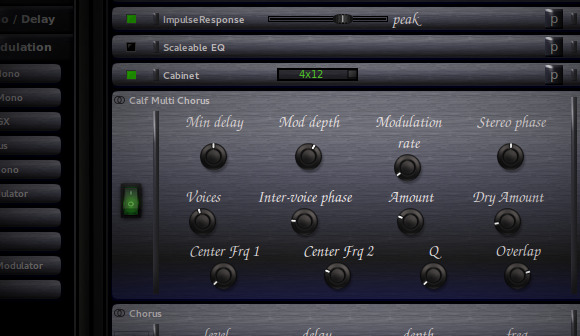Guitarix gets octaver plugin, loads external effects
Hermann Meyer released a new version of Guitarix, free/libre guitar FX processor. If you are looking for something that (vaguely) resembles Amplitube or Guitar Rig on Linux, you might want to check this out.
The new version features a long anticipated octaver effect that somewhat misleadingly was called ‘Detune’. What it really does is adding a copy of the input stream with a hardcoded octave-large pitch shift upwards or downwards and an optional detune of up to 1/3 of a semitone from the shifted tone.

In high quality mode the octaver produces reasonable output from a crunch, but introduces a significant latency even when you choose latency correction. In the real-time mode the latency is more then bearable, but the quality suffers. You really don’t want to use the low quality mode, because you get neither quality, no real-time processing. If you process clean (no crunch) guitar sound, the quality is somewhat debatable even in the high quality mode.
Apart from that, there’s a Baxandall tonestack now (internal only), a Zita convolver based shimmer called GxShimmizita (LV2), and a self-explanatory named GxSwitchedTremolo effect (LV2).
A much appreciated new feature is an ability to insert any installed LADSPA or LV2 effect into the FX chain, so you are not married to internal implementations of chorus, delay etc. anymore.

Go to ‘Plugins > LADSPA/LV2 plugins’ (Ctrl+U) and mark the effect you want to be used from withing Guitarix, then click Save. Guitarix was automatically distribute the effects across FX categories in its window. Then you can drag’n’drop new effects as usual.
Get Guitarix 0.30.0 at SourceForge.
This, however, isn’t all news. In June, developers released two LV2 plugins:
- GxBluemann — combines a tube screamer, a 12ax7 tube based amp, a Baxandall tonestack and a cabinet. It has no native UI, and the CPU load is merely ~5%.
- GxRectifier — an amp made with Orange AD200 in mind, but instead of a single ECC83 tube emulation it has 2×ECC83, 1×ECC81, and 4×6550. Also, it has a 2-band Baxandall tonestack instead of the original 3-band one, as well as a rectifier and a 4×10 cabinet. Hermann is looking forward to feedback from bass players.
Finally, the SpecMatch tool that generates IR files is now shipped separately. You can get it at SourceForge as well.
Patreon subscribers get early access to my posts. If you are feeling generous, you can also make a one-time donation on BuyMeACoffee.
